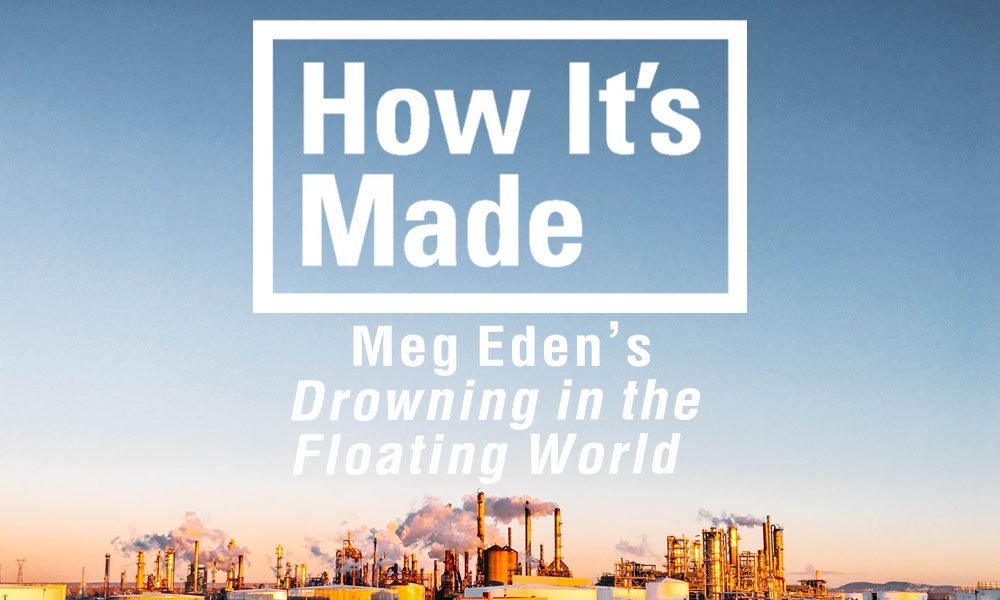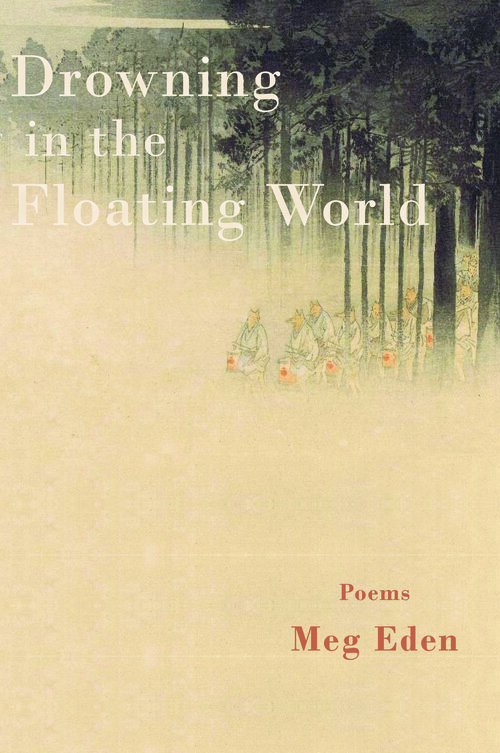How It’s Made: Meg Eden’s Drowning in the Floating World

We’re so happy to have had the chance to look under the hood of Meg Eden’s newest collection from Press 53, Drowning in the Floating World, which “immerses us into the Japanese natural disaster known as 3/11: the 2011 Tōhoku earthquake and tsunami, and subsequent Fukushima Daiichi nuclear disaster.” With our How It’s Made series, we endeavor to take away some of that ever-present mystery of how a collection comes to being.
What were the most joyful moments of Drowning in the Floating World’s journey to publication?
Meg Eden: I’m not sure I can apply the word joyful with this collection—but I know what you mean. This material was so painful to work through, but also so rewarding and meaningful. As a result, I carry something inside me that will never go away, and I will never look at tsunamis—or even large bodies of water—the same way. I think that in the development and writing process, those meaningful moments came when I had that “aha” moment, that realization where I could see the disaster in a new way. When I could transform it. In graduate school, I took this incredible translation course with Michael Collier, and spent the semester diving into Shuntaro Tanikawa’s incredible work. His magical realism, how he takes the mundane and sees it as this spectacular thing, really inspired me. I wanted to take the pain, the disaster, and try to see it with a Tanikawa-esque lens. Through that process, it transformed—and there’s something about that creative process that allows for coping. I think this is why we as people consume and create fairy tales and mythology. By telling stories, we can remember reality but also transform it, making something new.
Every finalist award for a contest was bittersweet—it was great to see the collection wasn’t completely ignored, but also painful to see what could’ve happened. I have so many notes in my prayer journal of “I think it’s ready—why hasn’t it found a home yet?” In hindsight, I can see that it was because the right home wasn’t found yet, but that it would be. Working with my editor Chris Forrest has been one of the most incredibly meaningful moments—he’s given such incredible thought, care and support to these poems. He’s dug deeper into them than I even did when writing them at times! He got the poems without me explaining them to him, and he invested so much into them. A poet can’t ask for more than that.
What were the toughest moments you faced while getting the collection to the world and what have you taken away from them?
The waits and the rejection letters are always hard. You invest so much in these poems. They’re like pages of skin you’ve cut off your body and stitched together with your toenails. It’s such a part of yourself, and it’s so painful to hear someone saying no. But there are so many amazing poetry collections out there! The competition has never been so fierce. I say competition as in, each publisher can only publish so many collections. That’s just the reality. I hated that; I wanted my work to “make the cut.” But I’m learning to take it all less personally. To persist, even when I want to give up. God seems to work it so that my writing finds a home when it’s ready—and/or when I’m ready. Sometimes I need the wait to be humbled and grow, and that’s perhaps the hardest pill to swallow. So learning to wait was one of the toughest parts, for sure.
An author never really works alone—without whose support would the book not have made it across the finish line?
Oh, everyone—and I mean everyone. Everyone who read the poems and manuscript in their various stages of completion. Every editor that published poems from the collection in their journals and believed in my work. Every contest judge who selected a poem from this collection and gave their kind words. All my professors and mentors who wouldn’t let me get away with my crap, and pushed me to be a better writer. All the editors who couldn’t publish Drowning, but left me kind notes on what they loved about it, cheering me on. All my poet friends who could commiserate about the waits, but spurred me on to persist. Everyone who heard about Drowning before it was even accepted for publication—for example, I did a panel with some other poets at a comic convention, and one person came up after I read and said something like, “Let me know when your book comes out—I want to buy it.” The girl who, at a poetry event on campus, said that she was there during 3/11 and could never write about it, but that she’s so grateful for folks like me who can write about it, to tell her and others’ stories. All of the survivors of 3/11 who have shared their stories. I could go on and on. It takes a village to write a book. No one works in a vacuum. Every day I become more and more humbled about just how little I bring to the table.
What did you learn about writing and poetry over the journey of these poems?
I learned that writing takes time, and to be patient. I thought the collection was “ready” in 2015, but it obviously wasn’t. It’s taken rounds of feedback, revision, and self-reflection to get the collection right. This collection is one of the many projects that’s been used to teach me that I need to revise my definition of “ready.” There’s no rush to publish. It feels like there is. I want teaching positions, and they look at your publication record—but you can’t put that external pressure on the craft. Do something else to get bread on the table. Don’t do that to your poems. The poems will be ready when they’re ready. Panicking with your own expectations and deadlines won’t make the process go any faster.
What was the favorite piece of media or art you consumed while writing these poems?
This is so tough—I consumed so much to write this collection. So many photos, videos, recordings, interviews, articles, books. It was all incredible, but also overwhelming—there’s only so much you can do at a time. I think one of the things I was particularly drawn to were photos and databases of debris from the disaster that was washing up on US shores. Objects carry so many stories. Seeing those objects—one day functional and valuable, next day detritus floating in the ocean—made me ask so many questions about their previous owners, their lives, and the things we carry. It really got the gears turning in my head. Also, I’ve always had a heart for Japanese mythology, so I think getting to dive into that again was particularly satisfying, and making connections with previous knowledge I held. The more I dug, the more I saw just how water connects everything in Japanese–it’s used in reference for life, death, ghosts, pleasure. The connections were incredible.
What’s your one sentence piece of advice for poets currently putting a collection together?
Keep tinkering with those poems until the collection’s sat in a drawer for 1+ years—when you’re still in love, and have only minor edits, then you know it’s ready.
Meg Eden‘s father has worked in Japan for most of her life, so she considers Japan her second home. Her work is published or forthcoming in magazines including Prairie Schooner, Poetry Northwest, Crab Orchard Review, RHINO and CV2. She teaches creative writing at Anne Arundel Community College and the MA program at Southern New Hampshire University. She is the author of five poetry chapbooks and the novel Post-High School Reality Quest (2017). She runs the Magfest MAGES Library blog, which posts accessible academic articles about video games. Find her online at www.megedenbooks.com or on Twitter at @ConfusedNarwhal
Praise for Drowning in a Floating World
“Drowning in the Floating World by Meg Eden immerses us into the Japanese natural disaster known as 3/11: the 2011 Tōhoku earthquake and tsunami, and subsequent Fukushima Daiichi nuclear disaster. Relentless as the disaster itself, Eden seizes control of our deepest emotional centers, and, through insightful perspective, holds us in consideration of loss, helplessness, upheaval, and, perhaps most stirring, what to make of, and do with, survival. Her collection is also a cultural education, sure to encourage further reading and research. Drowning in the Floating World is, itself, a tsunami stone—a warning beacon to remind us to learn from disaster and, in doing so, honor all that’s lost.”
— Christopher Forrest, editor of Press 53’s Immersion Series
